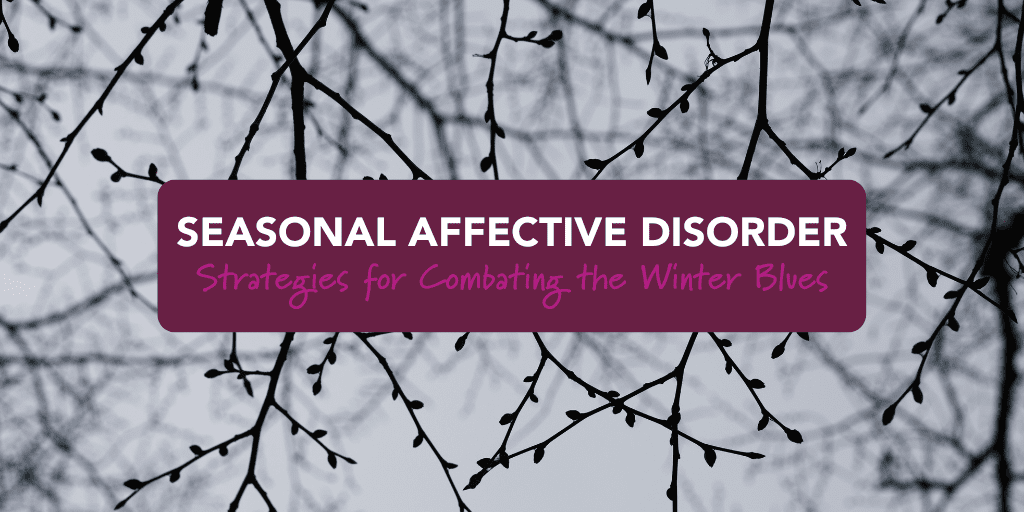– What It Is and What to Do About It
The winter season can be a difficult time for many, for a myriad of reasons. The pressure and stress of the holiday season, colder weather, and early sunsets can all have an impact on your mood, making feelings of melancholy run rampant during the colder months. This is especially true for those who already experience anxiety and/or depression. Feelings of mental turmoil can heighten during this time of the year.
This effect is actually a well-known and acknowledged condition, known as Seasonal Affective Disorder. According to the Mayo Clinic, Seasonal Affective Disorder can manifest symptoms such as:
- Feeling listless, sad or down most of the day, nearly every day
- Losing interest in activities you once enjoyed
- Having low energy and feeling sluggish
- Having problems with sleeping too much
- Experiencing carbohydrate cravings, overeating and weight gain
- Having difficulty concentrating
- Feeling hopeless, worthless or guilty
- Having thoughts of not wanting to live
Seasonal Affective Disorder affects millions every year, and can make going about your day-to-day routine exceptionally difficult. Some common methods to help combat these feelings include:
- Medications and therapy
- Phototherapy
- A practice of using bright lights within your home, to help maintain your circadian rhythm
- Prioritizing social activities with loved ones
- Exercising
- Maintaining a consistent schedule
- Journaling
- Abstaining from alcohol
- Taking walks and leaving blinds open for maximum sunlight exposure
– Strategies in Action
Building off these methods, we’ve come up with a few activities you could do to help you ward off the winter blues:
ADVENTURE WALK
Bundle up, set a timer, and go on a walk. It’s important to push yourself if you feel hesitant, but not dive in too deep all at once. If 15 minutes walking around your neighborhood is all you can manage – that’s a perfectly fine place to start. Take your phone on your walk to help you pay attention to your surroundings by trying these objectives:
- Make a note every time you see a bird. What does it look like and sound like?
- Take a picture of the sky, and every unique cloud
- Listen to an audiobook or podcast you enjoy
- Record your thoughts on voice memos
WRITE IT OUT
Create a journal to keep track of your experiences during the winter months. Make note of how you’ve been feeling day to day – consider numbering your overall daily mood, with 0 being the lowest and 10 being the highest. When you’re feeling particularly happy or sad – make a note of what you think is making you feel that way. It can help to write your thoughts and feelings down in general, and having a journal to look back at can help you prepare for the next winter season. Take note of things that made you feel particularly bad and work to avoid and prevent those, and fit as many of the good feeling reasons into your daily schedule as you can.
READ…WITH FRIENDS!
Organize a winter season book club with some friends. Schedule meetings with your group, set reading objectives, and discuss your progress and your feelings. Having a group-based activity to help stave off feelings of loneliness, and working on a task with clearly defined goals can help you feel like you’re accomplishing things throughout the week, and get you feeling excited for the near future.
TRY SOMETHING NEW
Consider picking up a hobby or craft that you have been interested in. There is a wide wealth of resources available online for all sorts of arts and crafts, and learning a new hobby or skill can be a great way to pull you out of the winter blues and have you feeling a sense of accomplishment.
– In Conclusion
Seasonal Depression is nothing to be embarrassed about, and it’s important to not sweep your feelings under the rug when you’re feeling down. If you’re feeling particularly affected by the changing seasons, know that you’re not alone, and that help and resources are out there. Mental health struggles can feel like insurmountable challenges, but taking care of yourself just as much as you would for an bodily injury or illness is a strong step towards maintaining your overall well-being.
For more information on Seasonal Affective Disorder, please see the provided links below:
- Cleveland Clinic – Seasonal Depression
- Mayo Clinic – Seasonal Affective Disorder
- NIMH – Seasonal Affective Disorder
